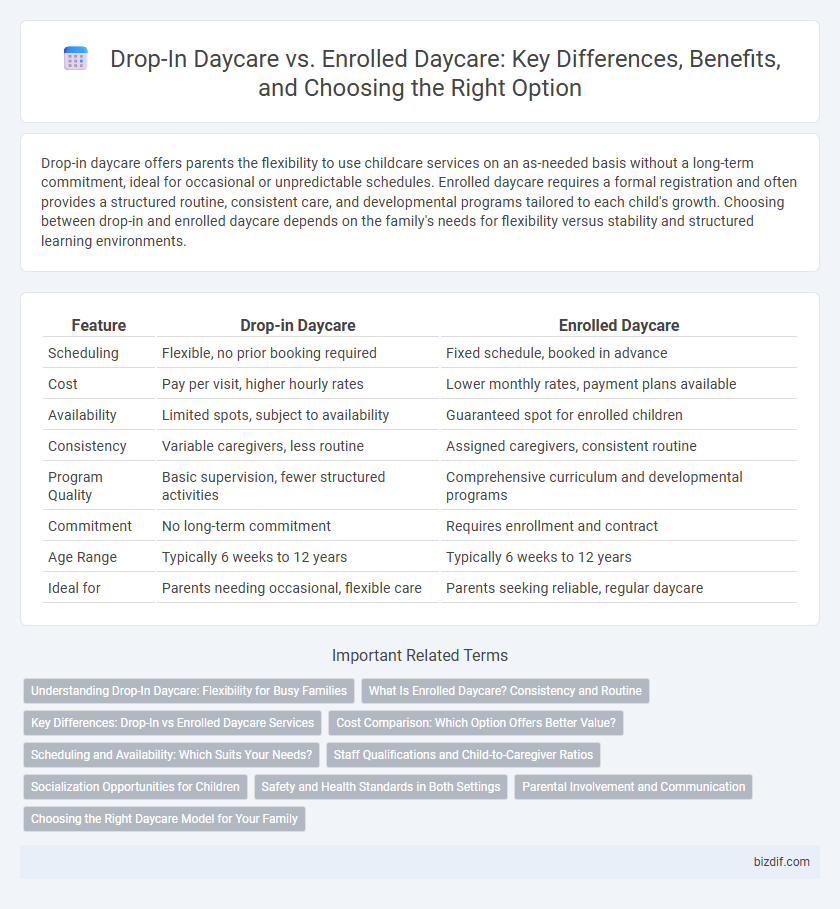Drop-in daycare offers parents the flexibility to use childcare services on an as-needed basis without a long-term commitment, ideal for occasional or unpredictable schedules. Enrolled daycare requires a formal registration and often provides a structured routine, consistent care, and developmental programs tailored to each child's growth. Choosing between drop-in and enrolled daycare depends on the family's needs for flexibility versus stability and structured learning environments.
Table of Comparison
| Feature | Drop-in Daycare | Enrolled Daycare |
|---|---|---|
| Scheduling | Flexible, no prior booking required | Fixed schedule, booked in advance |
| Cost | Pay per visit, higher hourly rates | Lower monthly rates, payment plans available |
| Availability | Limited spots, subject to availability | Guaranteed spot for enrolled children |
| Consistency | Variable caregivers, less routine | Assigned caregivers, consistent routine |
| Program Quality | Basic supervision, fewer structured activities | Comprehensive curriculum and developmental programs |
| Commitment | No long-term commitment | Requires enrollment and contract |
| Age Range | Typically 6 weeks to 12 years | Typically 6 weeks to 12 years |
| Ideal for | Parents needing occasional, flexible care | Parents seeking reliable, regular daycare |
Understanding Drop-In Daycare: Flexibility for Busy Families
Drop-in daycare offers flexible childcare options without long-term commitments, ideal for families with unpredictable schedules. Unlike enrolled daycare, which requires advance registration and regular attendance, drop-in services allow parents to access quality care on an as-needed basis. This convenience supports busy families managing work, appointments, and other responsibilities by providing reliable, short-term childcare.
What Is Enrolled Daycare? Consistency and Routine
Enrolled daycare refers to a structured child care program where children attend regularly on a set schedule, promoting consistency and routine essential for early development. This type of daycare supports stable social interactions, predictable daily activities, and continuous learning environments tailored to each child's developmental stage. Consistent attendance at enrolled daycare fosters emotional security and strengthens cognitive skills through ongoing, routine-based engagement.
Key Differences: Drop-In vs Enrolled Daycare Services
Drop-in daycare offers flexible, on-demand childcare without long-term commitments, ideal for parents needing occasional care. Enrolled daycare requires advance registration and regular attendance, providing structured routines and consistent caregiver-child relationships. Key differences include cost structure, scheduling flexibility, and the level of personalized care, with enrolled daycare typically offering more stability and developmental support.
Cost Comparison: Which Option Offers Better Value?
Drop-in daycare typically costs more per hour or day compared to enrolled daycare due to its flexible, on-demand nature, making it ideal for parents needing occasional care. Enrolled daycare often offers lower hourly rates through weekly or monthly contracts, providing better value for families requiring consistent childcare. Careful consideration of usage frequency and budget helps determine the most cost-effective option between these two daycare models.
Scheduling and Availability: Which Suits Your Needs?
Drop-in daycare offers flexible scheduling, allowing parents to access care on an as-needed basis without long-term commitments, ideal for irregular work hours or occasional use. Enrolled daycare requires a fixed schedule with set days and hours, providing consistency and guaranteed availability but less flexibility for sudden changes. Choosing between drop-in and enrolled daycare depends on your need for adaptability versus routine stability in your child care planning.
Staff Qualifications and Child-to-Caregiver Ratios
Drop-in daycare centers often have varied staff qualifications and higher child-to-caregiver ratios due to their flexible admission policies, which can impact personalized care quality. Enrolled daycare facilities typically adhere to strict regulations requiring certified educators with specialized training and maintain lower child-to-caregiver ratios to ensure individualized attention and safety. These staffing standards in enrolled daycare settings contribute to more consistent developmental support and supervision for children.
Socialization Opportunities for Children
Drop-in daycare offers flexible, occasional attendance that exposes children to diverse peer groups, enhancing adaptability and social interaction skills. Enrolled daycare provides consistent, regular attendance, fostering deeper relationships and a stable social environment essential for long-term social development. Both models support socialization, but enrolled daycare typically enables stronger peer bonding and collaboration over time.
Safety and Health Standards in Both Settings
Drop-in daycare and enrolled daycare both adhere to strict safety and health standards regulated by local and federal agencies to ensure child well-being. Enrolled daycare typically offers consistent health monitoring and personalized emergency plans tailored to each child, while drop-in daycare maintains universal hygiene protocols and staff training to manage varied attendance. Both settings implement rigorous sanitization routines, staff background checks, and compliance with immunization requirements to minimize health risks.
Parental Involvement and Communication
Drop-in daycare offers flexible parental involvement with occasional updates, allowing parents to engage as needed without a fixed schedule. Enrolled daycare programs typically provide structured communication channels, including regular progress reports and scheduled meetings, fostering consistent parental engagement. Effective communication in enrolled daycare supports stronger collaboration between caregivers and parents, enhancing child development monitoring.
Choosing the Right Daycare Model for Your Family
Drop-in daycare offers flexible, as-needed care ideal for parents with irregular schedules, while enrolled daycare provides consistent, structured environments promoting social development and routine for children. Families should evaluate factors such as childcare frequency, budget, and the child's social needs when choosing between the convenience of drop-in services and the stability of enrolled programs. Selecting the right daycare model ensures a balanced approach to caregiving that aligns with both the child's well-being and family lifestyle.
Drop-in daycare vs enrolled daycare Infographic

 bizdif.com
bizdif.com